Strategic Management Report: Tesco's Challenges and Analysis-MBA 7013
VerifiedAdded on 2023/06/11
|17
|6112
|187
Report
AI Summary
This report provides an extended strategic analysis of Tesco, a leading UK supermarket chain, using various strategic management tools and concepts. It begins with an overview of Tesco's organizational context, including its history, mission, and strategic issues. The report critically evaluates relevant theories such as Porter's Five Forces, PESTLE, Balanced Scorecard, SWOT, VRIO, and BCG Matrix. It then applies these theories to analyze Tesco's current situation, identifying strengths, weaknesses, opportunities, and threats. The analysis covers aspects like competitive rivalry, market dynamics, and resource capabilities. The report concludes with recommendations for Tesco to achieve sustainable competitive advantage and includes a reflective assessment of the learning journey.
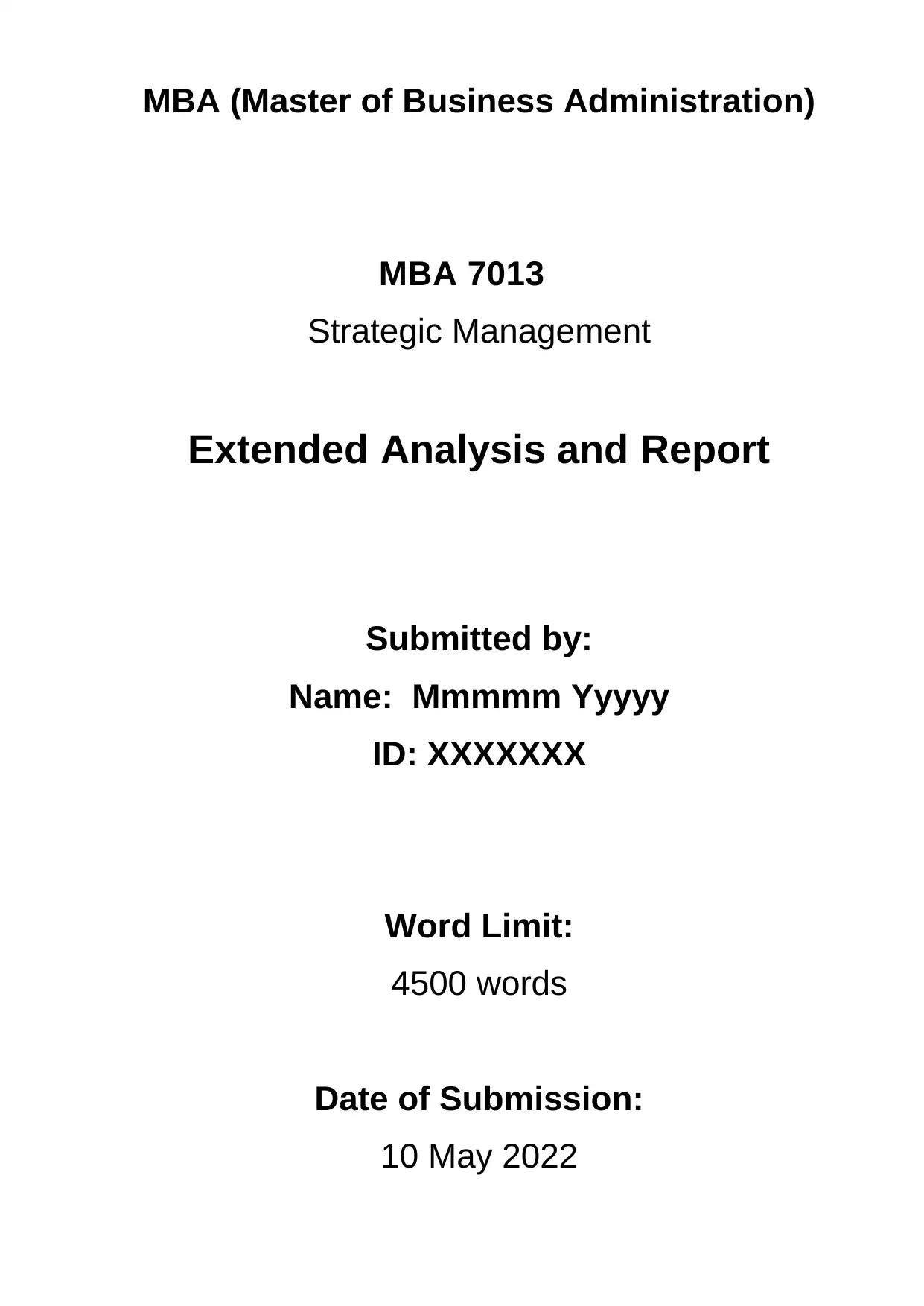
MBA (Master of Business Administration)
MBA 7013
Strategic Management
Extended Analysis and Report
Submitted by:
Name: Mmmmm Yyyyy
ID: XXXXXXX
Word Limit:
4500 words
Date of Submission:
10 May 2022
MBA 7013
Strategic Management
Extended Analysis and Report
Submitted by:
Name: Mmmmm Yyyyy
ID: XXXXXXX
Word Limit:
4500 words
Date of Submission:
10 May 2022
Paraphrase This Document
Need a fresh take? Get an instant paraphrase of this document with our AI Paraphraser
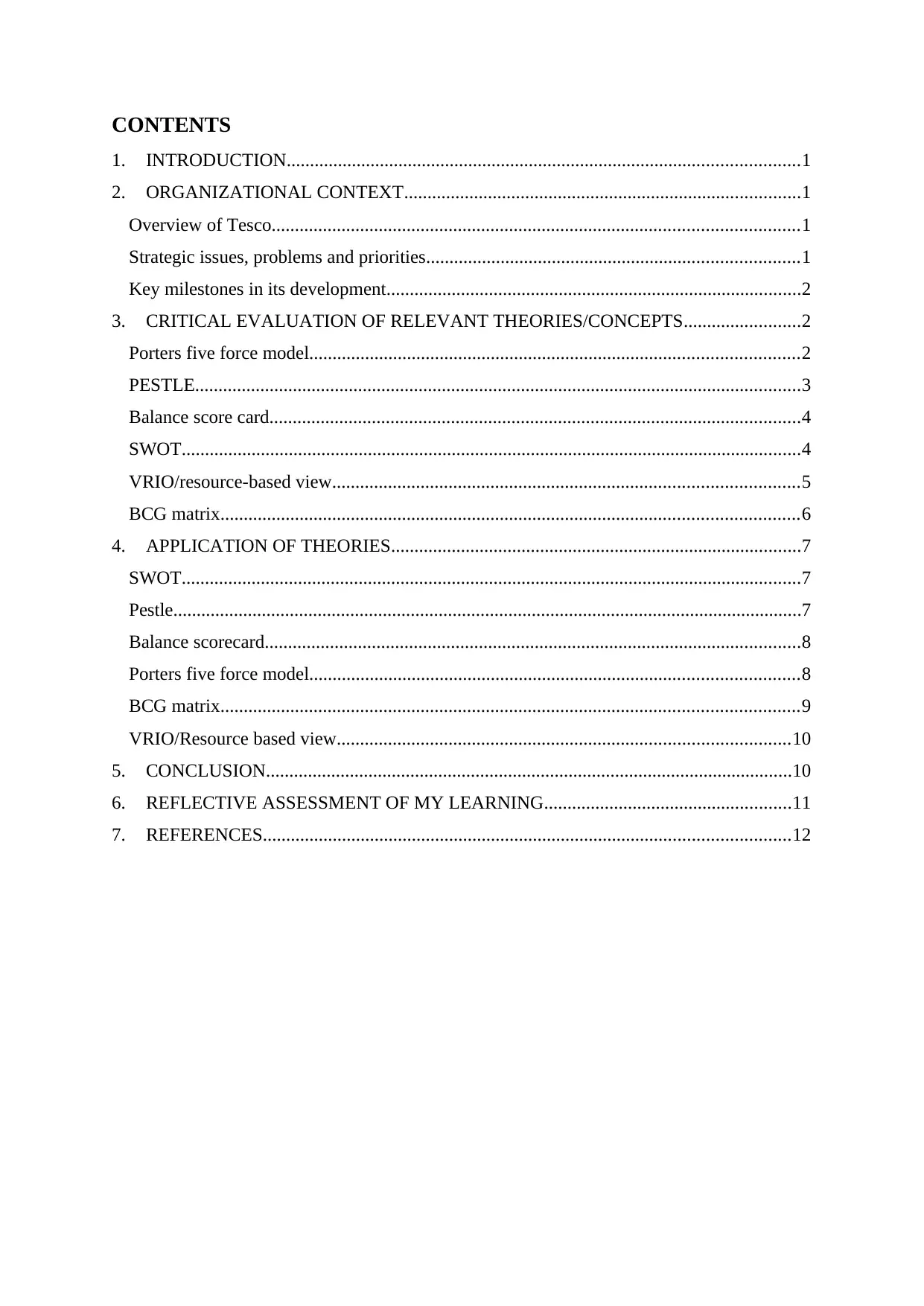
CONTENTS
1. INTRODUCTION..............................................................................................................1
2. ORGANIZATIONAL CONTEXT.....................................................................................1
Overview of Tesco.................................................................................................................1
Strategic issues, problems and priorities................................................................................1
Key milestones in its development.........................................................................................2
3. CRITICAL EVALUATION OF RELEVANT THEORIES/CONCEPTS.........................2
Porters five force model.........................................................................................................2
PESTLE..................................................................................................................................3
Balance score card..................................................................................................................4
SWOT.....................................................................................................................................4
VRIO/resource-based view....................................................................................................5
BCG matrix............................................................................................................................6
4. APPLICATION OF THEORIES........................................................................................7
SWOT.....................................................................................................................................7
Pestle.......................................................................................................................................7
Balance scorecard...................................................................................................................8
Porters five force model.........................................................................................................8
BCG matrix............................................................................................................................9
VRIO/Resource based view.................................................................................................10
5. CONCLUSION.................................................................................................................10
6. REFLECTIVE ASSESSMENT OF MY LEARNING.....................................................11
7. REFERENCES.................................................................................................................12
1. INTRODUCTION..............................................................................................................1
2. ORGANIZATIONAL CONTEXT.....................................................................................1
Overview of Tesco.................................................................................................................1
Strategic issues, problems and priorities................................................................................1
Key milestones in its development.........................................................................................2
3. CRITICAL EVALUATION OF RELEVANT THEORIES/CONCEPTS.........................2
Porters five force model.........................................................................................................2
PESTLE..................................................................................................................................3
Balance score card..................................................................................................................4
SWOT.....................................................................................................................................4
VRIO/resource-based view....................................................................................................5
BCG matrix............................................................................................................................6
4. APPLICATION OF THEORIES........................................................................................7
SWOT.....................................................................................................................................7
Pestle.......................................................................................................................................7
Balance scorecard...................................................................................................................8
Porters five force model.........................................................................................................8
BCG matrix............................................................................................................................9
VRIO/Resource based view.................................................................................................10
5. CONCLUSION.................................................................................................................10
6. REFLECTIVE ASSESSMENT OF MY LEARNING.....................................................11
7. REFERENCES.................................................................................................................12
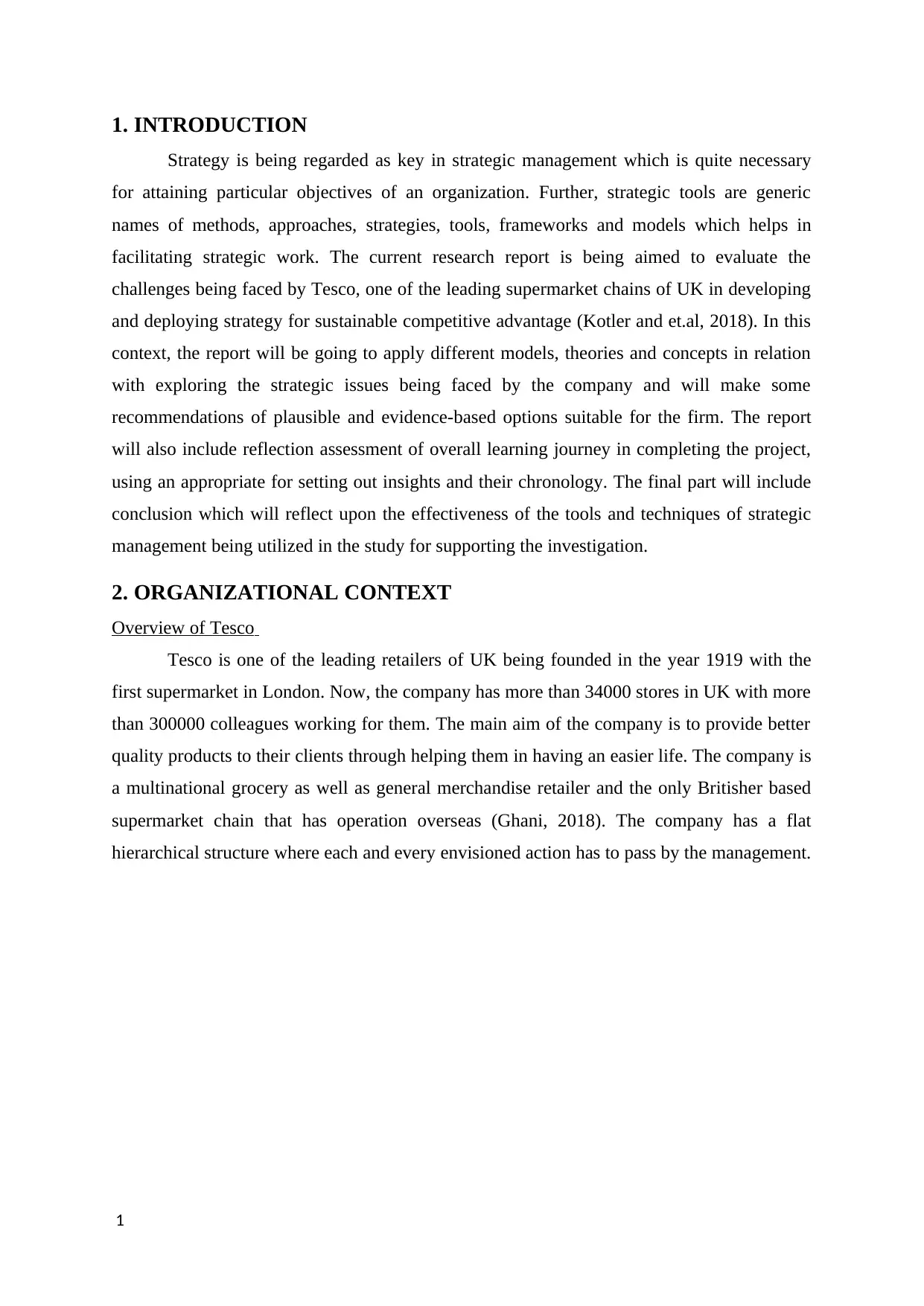
1. INTRODUCTION
Strategy is being regarded as key in strategic management which is quite necessary
for attaining particular objectives of an organization. Further, strategic tools are generic
names of methods, approaches, strategies, tools, frameworks and models which helps in
facilitating strategic work. The current research report is being aimed to evaluate the
challenges being faced by Tesco, one of the leading supermarket chains of UK in developing
and deploying strategy for sustainable competitive advantage (Kotler and et.al, 2018). In this
context, the report will be going to apply different models, theories and concepts in relation
with exploring the strategic issues being faced by the company and will make some
recommendations of plausible and evidence-based options suitable for the firm. The report
will also include reflection assessment of overall learning journey in completing the project,
using an appropriate for setting out insights and their chronology. The final part will include
conclusion which will reflect upon the effectiveness of the tools and techniques of strategic
management being utilized in the study for supporting the investigation.
2. ORGANIZATIONAL CONTEXT
Overview of Tesco
Tesco is one of the leading retailers of UK being founded in the year 1919 with the
first supermarket in London. Now, the company has more than 34000 stores in UK with more
than 300000 colleagues working for them. The main aim of the company is to provide better
quality products to their clients through helping them in having an easier life. The company is
a multinational grocery as well as general merchandise retailer and the only Britisher based
supermarket chain that has operation overseas (Ghani, 2018). The company has a flat
hierarchical structure where each and every envisioned action has to pass by the management.
1
Strategy is being regarded as key in strategic management which is quite necessary
for attaining particular objectives of an organization. Further, strategic tools are generic
names of methods, approaches, strategies, tools, frameworks and models which helps in
facilitating strategic work. The current research report is being aimed to evaluate the
challenges being faced by Tesco, one of the leading supermarket chains of UK in developing
and deploying strategy for sustainable competitive advantage (Kotler and et.al, 2018). In this
context, the report will be going to apply different models, theories and concepts in relation
with exploring the strategic issues being faced by the company and will make some
recommendations of plausible and evidence-based options suitable for the firm. The report
will also include reflection assessment of overall learning journey in completing the project,
using an appropriate for setting out insights and their chronology. The final part will include
conclusion which will reflect upon the effectiveness of the tools and techniques of strategic
management being utilized in the study for supporting the investigation.
2. ORGANIZATIONAL CONTEXT
Overview of Tesco
Tesco is one of the leading retailers of UK being founded in the year 1919 with the
first supermarket in London. Now, the company has more than 34000 stores in UK with more
than 300000 colleagues working for them. The main aim of the company is to provide better
quality products to their clients through helping them in having an easier life. The company is
a multinational grocery as well as general merchandise retailer and the only Britisher based
supermarket chain that has operation overseas (Ghani, 2018). The company has a flat
hierarchical structure where each and every envisioned action has to pass by the management.
1
⊘ This is a preview!⊘
Do you want full access?
Subscribe today to unlock all pages.

Trusted by 1+ million students worldwide
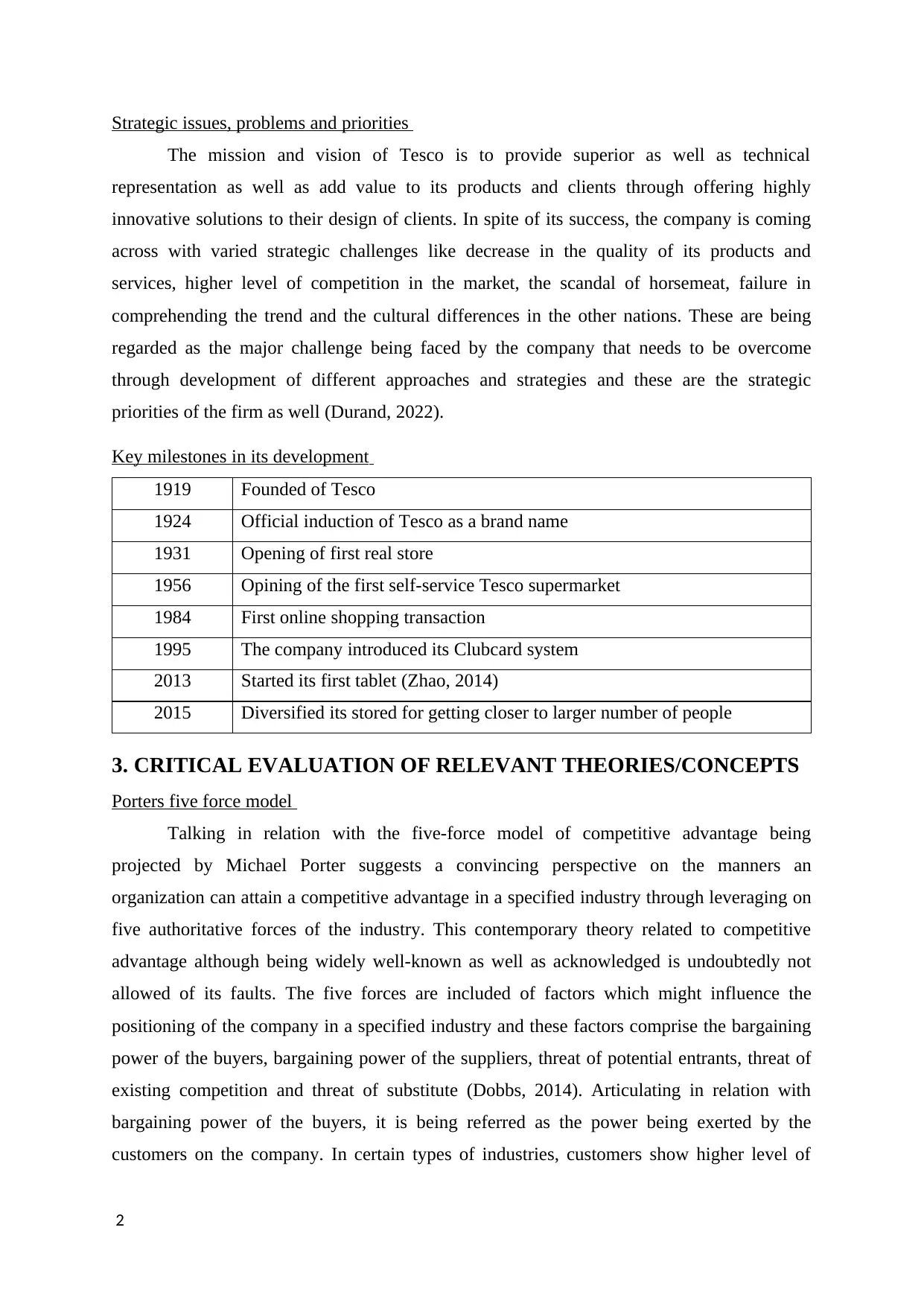
Strategic issues, problems and priorities
The mission and vision of Tesco is to provide superior as well as technical
representation as well as add value to its products and clients through offering highly
innovative solutions to their design of clients. In spite of its success, the company is coming
across with varied strategic challenges like decrease in the quality of its products and
services, higher level of competition in the market, the scandal of horsemeat, failure in
comprehending the trend and the cultural differences in the other nations. These are being
regarded as the major challenge being faced by the company that needs to be overcome
through development of different approaches and strategies and these are the strategic
priorities of the firm as well (Durand, 2022).
Key milestones in its development
1919 Founded of Tesco
1924 Official induction of Tesco as a brand name
1931 Opening of first real store
1956 Opining of the first self-service Tesco supermarket
1984 First online shopping transaction
1995 The company introduced its Clubcard system
2013 Started its first tablet (Zhao, 2014)
2015 Diversified its stored for getting closer to larger number of people
3. CRITICAL EVALUATION OF RELEVANT THEORIES/CONCEPTS
Porters five force model
Talking in relation with the five-force model of competitive advantage being
projected by Michael Porter suggests a convincing perspective on the manners an
organization can attain a competitive advantage in a specified industry through leveraging on
five authoritative forces of the industry. This contemporary theory related to competitive
advantage although being widely well-known as well as acknowledged is undoubtedly not
allowed of its faults. The five forces are included of factors which might influence the
positioning of the company in a specified industry and these factors comprise the bargaining
power of the buyers, bargaining power of the suppliers, threat of potential entrants, threat of
existing competition and threat of substitute (Dobbs, 2014). Articulating in relation with
bargaining power of the buyers, it is being referred as the power being exerted by the
customers on the company. In certain types of industries, customers show higher level of
2
The mission and vision of Tesco is to provide superior as well as technical
representation as well as add value to its products and clients through offering highly
innovative solutions to their design of clients. In spite of its success, the company is coming
across with varied strategic challenges like decrease in the quality of its products and
services, higher level of competition in the market, the scandal of horsemeat, failure in
comprehending the trend and the cultural differences in the other nations. These are being
regarded as the major challenge being faced by the company that needs to be overcome
through development of different approaches and strategies and these are the strategic
priorities of the firm as well (Durand, 2022).
Key milestones in its development
1919 Founded of Tesco
1924 Official induction of Tesco as a brand name
1931 Opening of first real store
1956 Opining of the first self-service Tesco supermarket
1984 First online shopping transaction
1995 The company introduced its Clubcard system
2013 Started its first tablet (Zhao, 2014)
2015 Diversified its stored for getting closer to larger number of people
3. CRITICAL EVALUATION OF RELEVANT THEORIES/CONCEPTS
Porters five force model
Talking in relation with the five-force model of competitive advantage being
projected by Michael Porter suggests a convincing perspective on the manners an
organization can attain a competitive advantage in a specified industry through leveraging on
five authoritative forces of the industry. This contemporary theory related to competitive
advantage although being widely well-known as well as acknowledged is undoubtedly not
allowed of its faults. The five forces are included of factors which might influence the
positioning of the company in a specified industry and these factors comprise the bargaining
power of the buyers, bargaining power of the suppliers, threat of potential entrants, threat of
existing competition and threat of substitute (Dobbs, 2014). Articulating in relation with
bargaining power of the buyers, it is being referred as the power being exerted by the
customers on the company. In certain types of industries, customers show higher level of
2
Paraphrase This Document
Need a fresh take? Get an instant paraphrase of this document with our AI Paraphraser
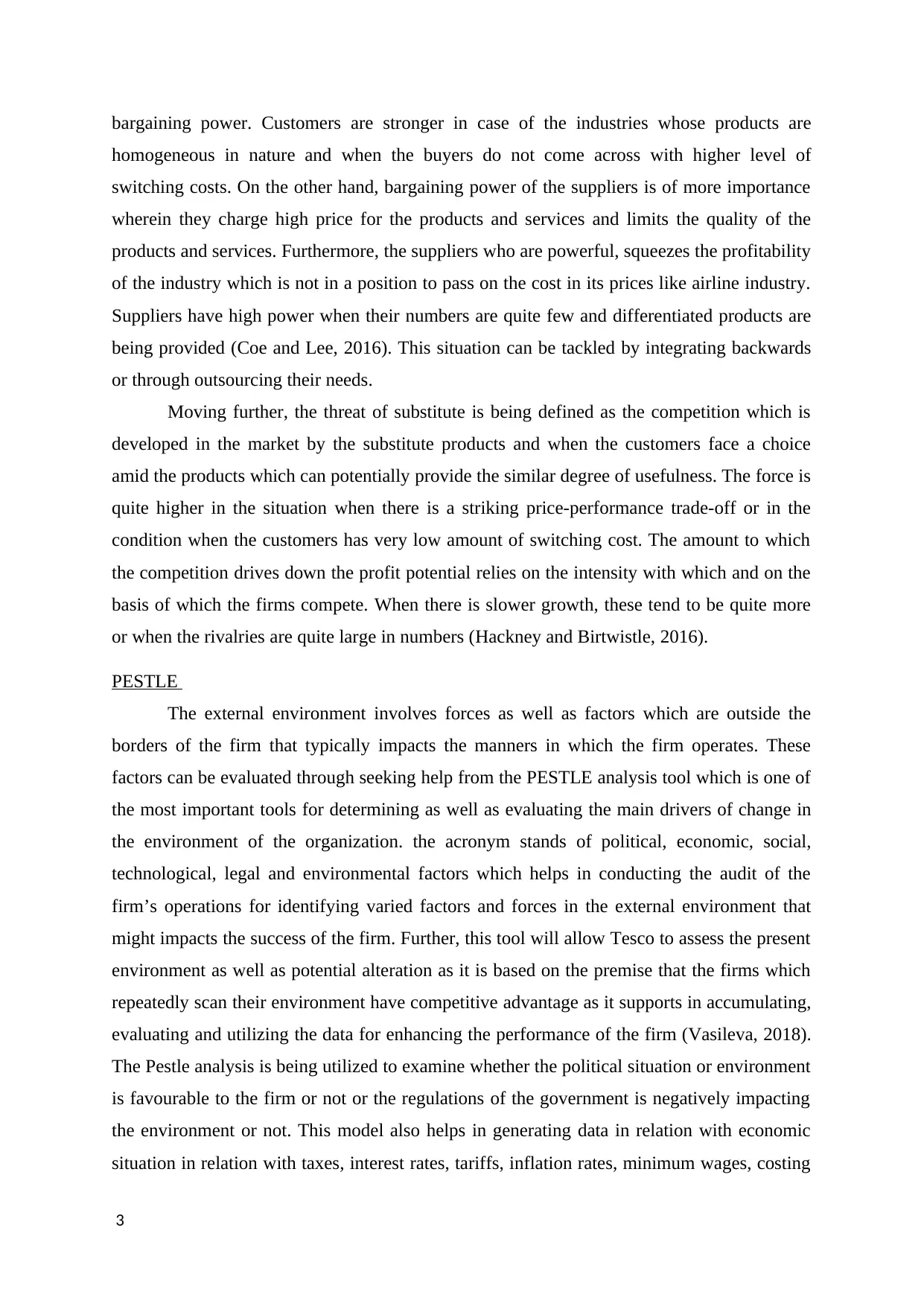
bargaining power. Customers are stronger in case of the industries whose products are
homogeneous in nature and when the buyers do not come across with higher level of
switching costs. On the other hand, bargaining power of the suppliers is of more importance
wherein they charge high price for the products and services and limits the quality of the
products and services. Furthermore, the suppliers who are powerful, squeezes the profitability
of the industry which is not in a position to pass on the cost in its prices like airline industry.
Suppliers have high power when their numbers are quite few and differentiated products are
being provided (Coe and Lee, 2016). This situation can be tackled by integrating backwards
or through outsourcing their needs.
Moving further, the threat of substitute is being defined as the competition which is
developed in the market by the substitute products and when the customers face a choice
amid the products which can potentially provide the similar degree of usefulness. The force is
quite higher in the situation when there is a striking price-performance trade-off or in the
condition when the customers has very low amount of switching cost. The amount to which
the competition drives down the profit potential relies on the intensity with which and on the
basis of which the firms compete. When there is slower growth, these tend to be quite more
or when the rivalries are quite large in numbers (Hackney and Birtwistle, 2016).
PESTLE
The external environment involves forces as well as factors which are outside the
borders of the firm that typically impacts the manners in which the firm operates. These
factors can be evaluated through seeking help from the PESTLE analysis tool which is one of
the most important tools for determining as well as evaluating the main drivers of change in
the environment of the organization. the acronym stands of political, economic, social,
technological, legal and environmental factors which helps in conducting the audit of the
firm’s operations for identifying varied factors and forces in the external environment that
might impacts the success of the firm. Further, this tool will allow Tesco to assess the present
environment as well as potential alteration as it is based on the premise that the firms which
repeatedly scan their environment have competitive advantage as it supports in accumulating,
evaluating and utilizing the data for enhancing the performance of the firm (Vasileva, 2018).
The Pestle analysis is being utilized to examine whether the political situation or environment
is favourable to the firm or not or the regulations of the government is negatively impacting
the environment or not. This model also helps in generating data in relation with economic
situation in relation with taxes, interest rates, tariffs, inflation rates, minimum wages, costing
3
homogeneous in nature and when the buyers do not come across with higher level of
switching costs. On the other hand, bargaining power of the suppliers is of more importance
wherein they charge high price for the products and services and limits the quality of the
products and services. Furthermore, the suppliers who are powerful, squeezes the profitability
of the industry which is not in a position to pass on the cost in its prices like airline industry.
Suppliers have high power when their numbers are quite few and differentiated products are
being provided (Coe and Lee, 2016). This situation can be tackled by integrating backwards
or through outsourcing their needs.
Moving further, the threat of substitute is being defined as the competition which is
developed in the market by the substitute products and when the customers face a choice
amid the products which can potentially provide the similar degree of usefulness. The force is
quite higher in the situation when there is a striking price-performance trade-off or in the
condition when the customers has very low amount of switching cost. The amount to which
the competition drives down the profit potential relies on the intensity with which and on the
basis of which the firms compete. When there is slower growth, these tend to be quite more
or when the rivalries are quite large in numbers (Hackney and Birtwistle, 2016).
PESTLE
The external environment involves forces as well as factors which are outside the
borders of the firm that typically impacts the manners in which the firm operates. These
factors can be evaluated through seeking help from the PESTLE analysis tool which is one of
the most important tools for determining as well as evaluating the main drivers of change in
the environment of the organization. the acronym stands of political, economic, social,
technological, legal and environmental factors which helps in conducting the audit of the
firm’s operations for identifying varied factors and forces in the external environment that
might impacts the success of the firm. Further, this tool will allow Tesco to assess the present
environment as well as potential alteration as it is based on the premise that the firms which
repeatedly scan their environment have competitive advantage as it supports in accumulating,
evaluating and utilizing the data for enhancing the performance of the firm (Vasileva, 2018).
The Pestle analysis is being utilized to examine whether the political situation or environment
is favourable to the firm or not or the regulations of the government is negatively impacting
the environment or not. This model also helps in generating data in relation with economic
situation in relation with taxes, interest rates, tariffs, inflation rates, minimum wages, costing
3
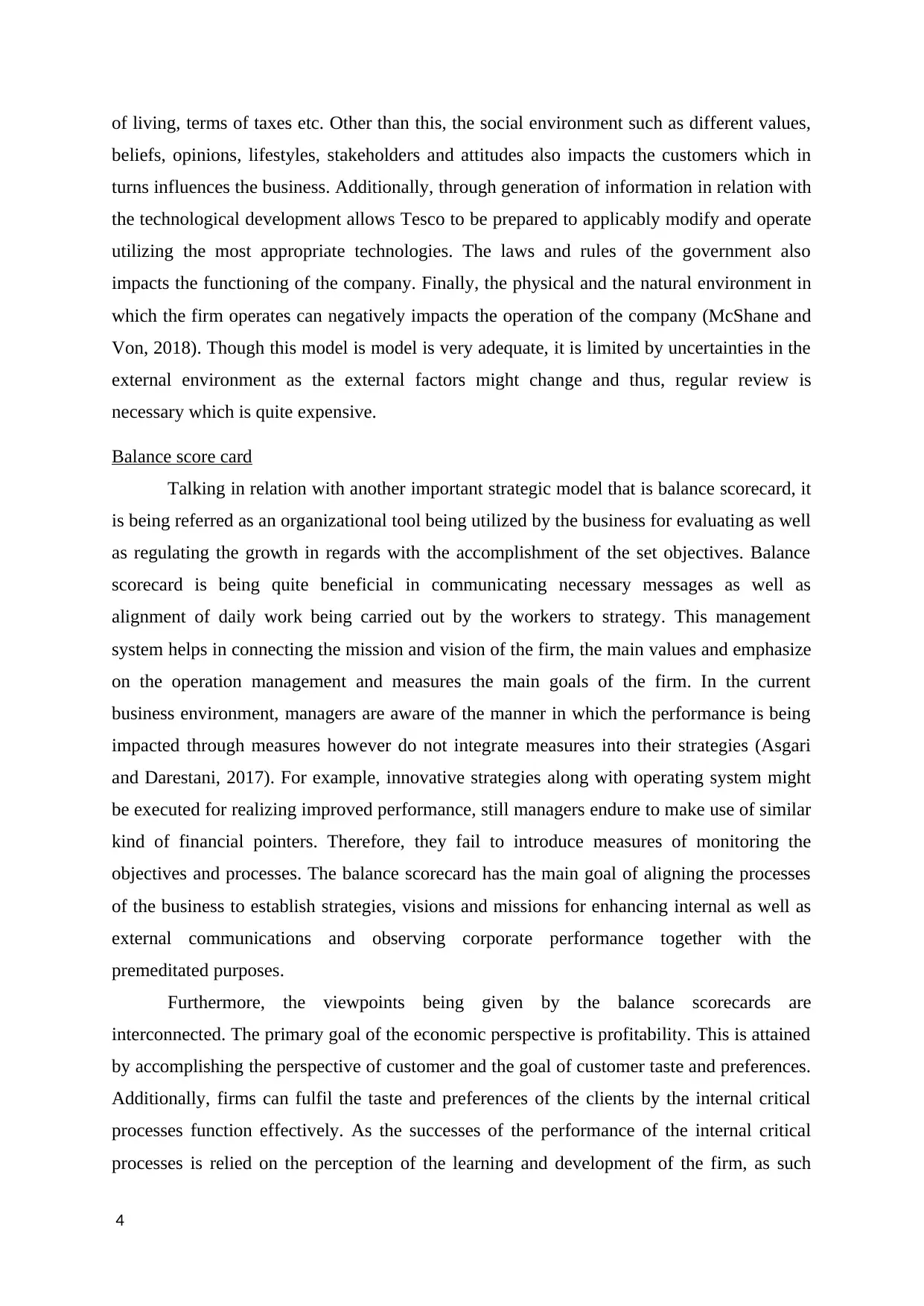
of living, terms of taxes etc. Other than this, the social environment such as different values,
beliefs, opinions, lifestyles, stakeholders and attitudes also impacts the customers which in
turns influences the business. Additionally, through generation of information in relation with
the technological development allows Tesco to be prepared to applicably modify and operate
utilizing the most appropriate technologies. The laws and rules of the government also
impacts the functioning of the company. Finally, the physical and the natural environment in
which the firm operates can negatively impacts the operation of the company (McShane and
Von, 2018). Though this model is model is very adequate, it is limited by uncertainties in the
external environment as the external factors might change and thus, regular review is
necessary which is quite expensive.
Balance score card
Talking in relation with another important strategic model that is balance scorecard, it
is being referred as an organizational tool being utilized by the business for evaluating as well
as regulating the growth in regards with the accomplishment of the set objectives. Balance
scorecard is being quite beneficial in communicating necessary messages as well as
alignment of daily work being carried out by the workers to strategy. This management
system helps in connecting the mission and vision of the firm, the main values and emphasize
on the operation management and measures the main goals of the firm. In the current
business environment, managers are aware of the manner in which the performance is being
impacted through measures however do not integrate measures into their strategies (Asgari
and Darestani, 2017). For example, innovative strategies along with operating system might
be executed for realizing improved performance, still managers endure to make use of similar
kind of financial pointers. Therefore, they fail to introduce measures of monitoring the
objectives and processes. The balance scorecard has the main goal of aligning the processes
of the business to establish strategies, visions and missions for enhancing internal as well as
external communications and observing corporate performance together with the
premeditated purposes.
Furthermore, the viewpoints being given by the balance scorecards are
interconnected. The primary goal of the economic perspective is profitability. This is attained
by accomplishing the perspective of customer and the goal of customer taste and preferences.
Additionally, firms can fulfil the taste and preferences of the clients by the internal critical
processes function effectively. As the successes of the performance of the internal critical
processes is relied on the perception of the learning and development of the firm, as such
4
beliefs, opinions, lifestyles, stakeholders and attitudes also impacts the customers which in
turns influences the business. Additionally, through generation of information in relation with
the technological development allows Tesco to be prepared to applicably modify and operate
utilizing the most appropriate technologies. The laws and rules of the government also
impacts the functioning of the company. Finally, the physical and the natural environment in
which the firm operates can negatively impacts the operation of the company (McShane and
Von, 2018). Though this model is model is very adequate, it is limited by uncertainties in the
external environment as the external factors might change and thus, regular review is
necessary which is quite expensive.
Balance score card
Talking in relation with another important strategic model that is balance scorecard, it
is being referred as an organizational tool being utilized by the business for evaluating as well
as regulating the growth in regards with the accomplishment of the set objectives. Balance
scorecard is being quite beneficial in communicating necessary messages as well as
alignment of daily work being carried out by the workers to strategy. This management
system helps in connecting the mission and vision of the firm, the main values and emphasize
on the operation management and measures the main goals of the firm. In the current
business environment, managers are aware of the manner in which the performance is being
impacted through measures however do not integrate measures into their strategies (Asgari
and Darestani, 2017). For example, innovative strategies along with operating system might
be executed for realizing improved performance, still managers endure to make use of similar
kind of financial pointers. Therefore, they fail to introduce measures of monitoring the
objectives and processes. The balance scorecard has the main goal of aligning the processes
of the business to establish strategies, visions and missions for enhancing internal as well as
external communications and observing corporate performance together with the
premeditated purposes.
Furthermore, the viewpoints being given by the balance scorecards are
interconnected. The primary goal of the economic perspective is profitability. This is attained
by accomplishing the perspective of customer and the goal of customer taste and preferences.
Additionally, firms can fulfil the taste and preferences of the clients by the internal critical
processes function effectively. As the successes of the performance of the internal critical
processes is relied on the perception of the learning and development of the firm, as such
4
⊘ This is a preview!⊘
Do you want full access?
Subscribe today to unlock all pages.

Trusted by 1+ million students worldwide
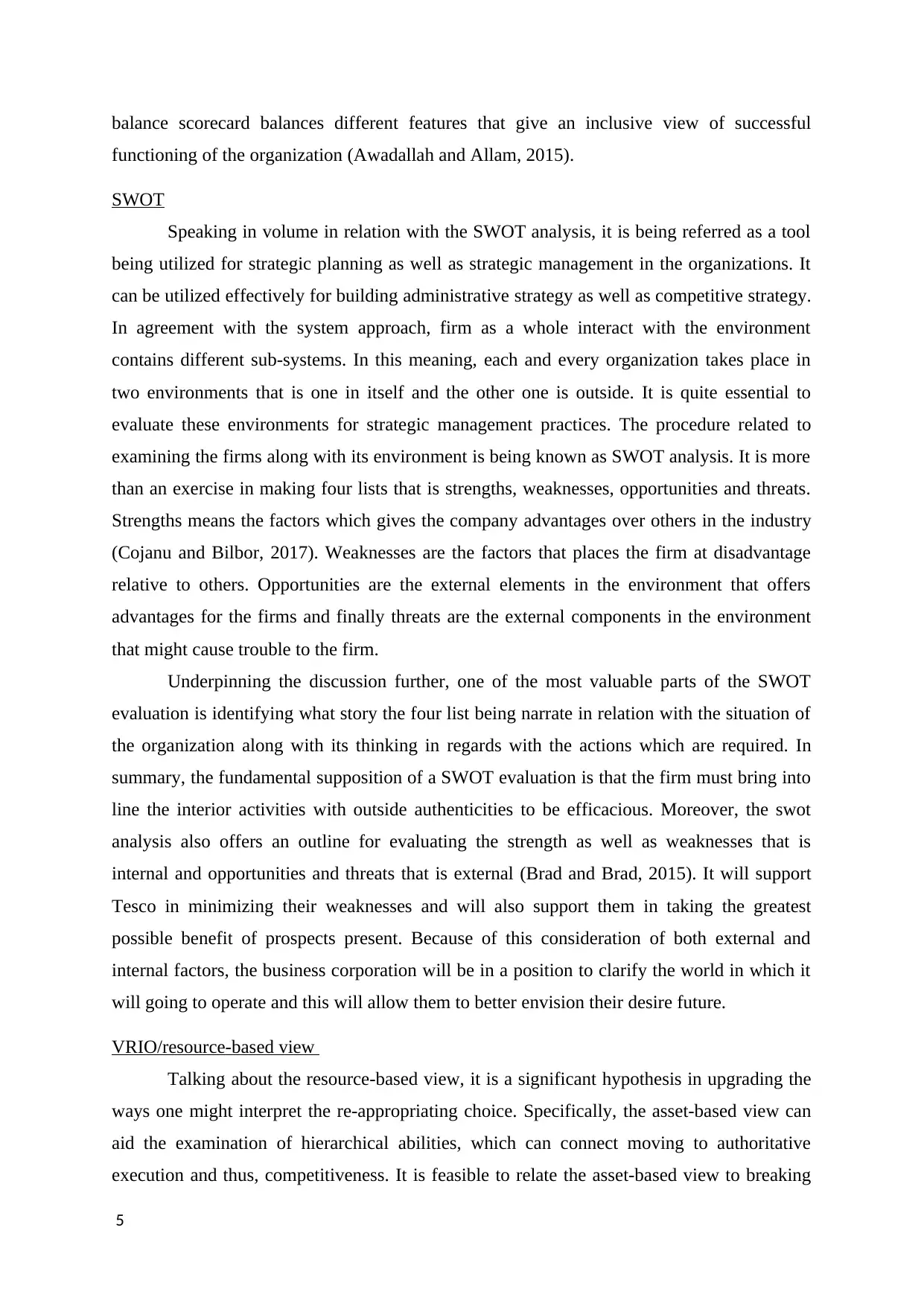
balance scorecard balances different features that give an inclusive view of successful
functioning of the organization (Awadallah and Allam, 2015).
SWOT
Speaking in volume in relation with the SWOT analysis, it is being referred as a tool
being utilized for strategic planning as well as strategic management in the organizations. It
can be utilized effectively for building administrative strategy as well as competitive strategy.
In agreement with the system approach, firm as a whole interact with the environment
contains different sub-systems. In this meaning, each and every organization takes place in
two environments that is one in itself and the other one is outside. It is quite essential to
evaluate these environments for strategic management practices. The procedure related to
examining the firms along with its environment is being known as SWOT analysis. It is more
than an exercise in making four lists that is strengths, weaknesses, opportunities and threats.
Strengths means the factors which gives the company advantages over others in the industry
(Cojanu and Bilbor, 2017). Weaknesses are the factors that places the firm at disadvantage
relative to others. Opportunities are the external elements in the environment that offers
advantages for the firms and finally threats are the external components in the environment
that might cause trouble to the firm.
Underpinning the discussion further, one of the most valuable parts of the SWOT
evaluation is identifying what story the four list being narrate in relation with the situation of
the organization along with its thinking in regards with the actions which are required. In
summary, the fundamental supposition of a SWOT evaluation is that the firm must bring into
line the interior activities with outside authenticities to be efficacious. Moreover, the swot
analysis also offers an outline for evaluating the strength as well as weaknesses that is
internal and opportunities and threats that is external (Brad and Brad, 2015). It will support
Tesco in minimizing their weaknesses and will also support them in taking the greatest
possible benefit of prospects present. Because of this consideration of both external and
internal factors, the business corporation will be in a position to clarify the world in which it
will going to operate and this will allow them to better envision their desire future.
VRIO/resource-based view
Talking about the resource-based view, it is a significant hypothesis in upgrading the
ways one might interpret the re-appropriating choice. Specifically, the asset-based view can
aid the examination of hierarchical abilities, which can connect moving to authoritative
execution and thus, competitiveness. It is feasible to relate the asset-based view to breaking
5
functioning of the organization (Awadallah and Allam, 2015).
SWOT
Speaking in volume in relation with the SWOT analysis, it is being referred as a tool
being utilized for strategic planning as well as strategic management in the organizations. It
can be utilized effectively for building administrative strategy as well as competitive strategy.
In agreement with the system approach, firm as a whole interact with the environment
contains different sub-systems. In this meaning, each and every organization takes place in
two environments that is one in itself and the other one is outside. It is quite essential to
evaluate these environments for strategic management practices. The procedure related to
examining the firms along with its environment is being known as SWOT analysis. It is more
than an exercise in making four lists that is strengths, weaknesses, opportunities and threats.
Strengths means the factors which gives the company advantages over others in the industry
(Cojanu and Bilbor, 2017). Weaknesses are the factors that places the firm at disadvantage
relative to others. Opportunities are the external elements in the environment that offers
advantages for the firms and finally threats are the external components in the environment
that might cause trouble to the firm.
Underpinning the discussion further, one of the most valuable parts of the SWOT
evaluation is identifying what story the four list being narrate in relation with the situation of
the organization along with its thinking in regards with the actions which are required. In
summary, the fundamental supposition of a SWOT evaluation is that the firm must bring into
line the interior activities with outside authenticities to be efficacious. Moreover, the swot
analysis also offers an outline for evaluating the strength as well as weaknesses that is
internal and opportunities and threats that is external (Brad and Brad, 2015). It will support
Tesco in minimizing their weaknesses and will also support them in taking the greatest
possible benefit of prospects present. Because of this consideration of both external and
internal factors, the business corporation will be in a position to clarify the world in which it
will going to operate and this will allow them to better envision their desire future.
VRIO/resource-based view
Talking about the resource-based view, it is a significant hypothesis in upgrading the
ways one might interpret the re-appropriating choice. Specifically, the asset-based view can
aid the examination of hierarchical abilities, which can connect moving to authoritative
execution and thus, competitiveness. It is feasible to relate the asset-based view to breaking
5
Paraphrase This Document
Need a fresh take? Get an instant paraphrase of this document with our AI Paraphraser
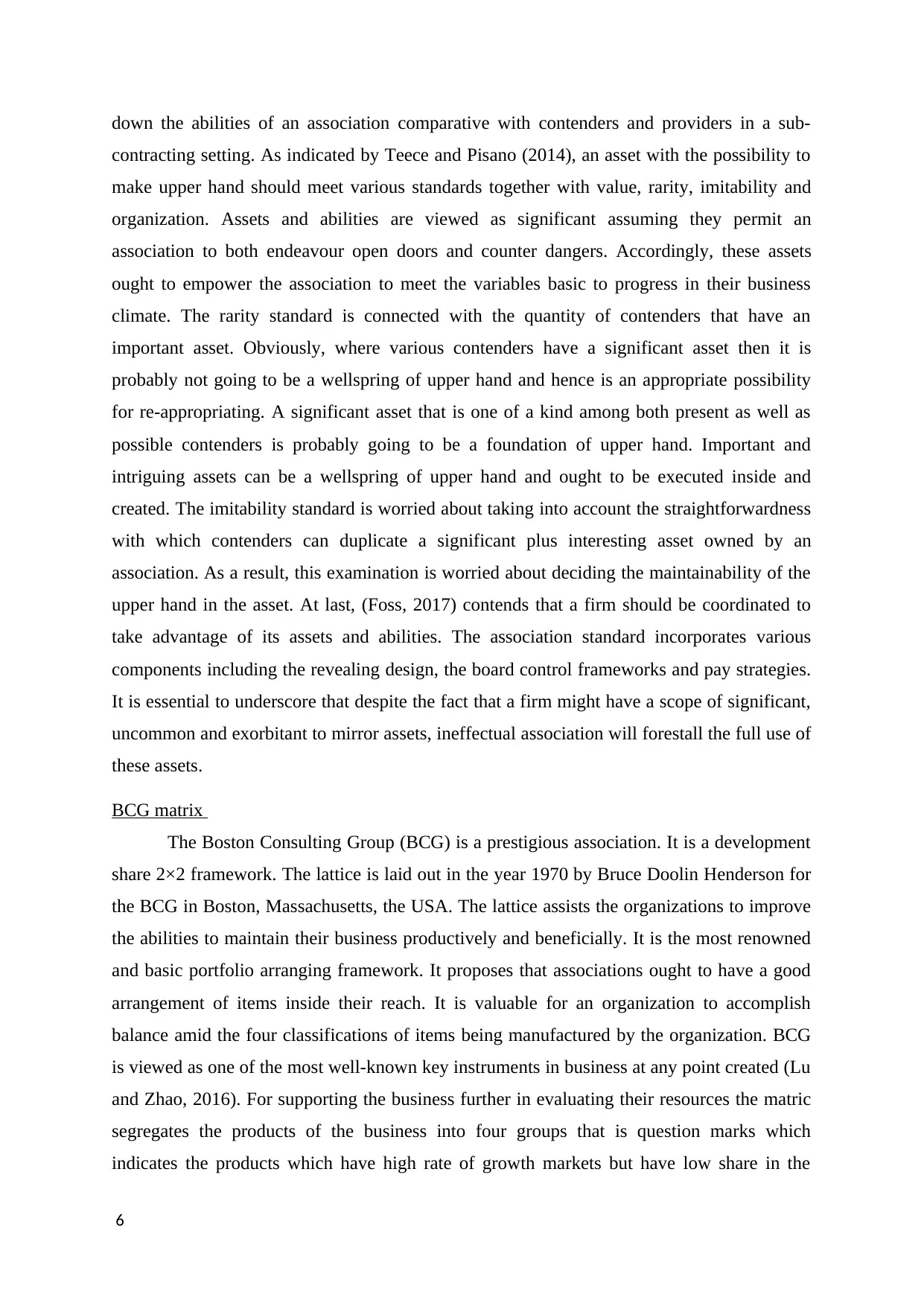
down the abilities of an association comparative with contenders and providers in a sub-
contracting setting. As indicated by Teece and Pisano (2014), an asset with the possibility to
make upper hand should meet various standards together with value, rarity, imitability and
organization. Assets and abilities are viewed as significant assuming they permit an
association to both endeavour open doors and counter dangers. Accordingly, these assets
ought to empower the association to meet the variables basic to progress in their business
climate. The rarity standard is connected with the quantity of contenders that have an
important asset. Obviously, where various contenders have a significant asset then it is
probably not going to be a wellspring of upper hand and hence is an appropriate possibility
for re-appropriating. A significant asset that is one of a kind among both present as well as
possible contenders is probably going to be a foundation of upper hand. Important and
intriguing assets can be a wellspring of upper hand and ought to be executed inside and
created. The imitability standard is worried about taking into account the straightforwardness
with which contenders can duplicate a significant plus interesting asset owned by an
association. As a result, this examination is worried about deciding the maintainability of the
upper hand in the asset. At last, (Foss, 2017) contends that a firm should be coordinated to
take advantage of its assets and abilities. The association standard incorporates various
components including the revealing design, the board control frameworks and pay strategies.
It is essential to underscore that despite the fact that a firm might have a scope of significant,
uncommon and exorbitant to mirror assets, ineffectual association will forestall the full use of
these assets.
BCG matrix
The Boston Consulting Group (BCG) is a prestigious association. It is a development
share 2×2 framework. The lattice is laid out in the year 1970 by Bruce Doolin Henderson for
the BCG in Boston, Massachusetts, the USA. The lattice assists the organizations to improve
the abilities to maintain their business productively and beneficially. It is the most renowned
and basic portfolio arranging framework. It proposes that associations ought to have a good
arrangement of items inside their reach. It is valuable for an organization to accomplish
balance amid the four classifications of items being manufactured by the organization. BCG
is viewed as one of the most well-known key instruments in business at any point created (Lu
and Zhao, 2016). For supporting the business further in evaluating their resources the matric
segregates the products of the business into four groups that is question marks which
indicates the products which have high rate of growth markets but have low share in the
6
contracting setting. As indicated by Teece and Pisano (2014), an asset with the possibility to
make upper hand should meet various standards together with value, rarity, imitability and
organization. Assets and abilities are viewed as significant assuming they permit an
association to both endeavour open doors and counter dangers. Accordingly, these assets
ought to empower the association to meet the variables basic to progress in their business
climate. The rarity standard is connected with the quantity of contenders that have an
important asset. Obviously, where various contenders have a significant asset then it is
probably not going to be a wellspring of upper hand and hence is an appropriate possibility
for re-appropriating. A significant asset that is one of a kind among both present as well as
possible contenders is probably going to be a foundation of upper hand. Important and
intriguing assets can be a wellspring of upper hand and ought to be executed inside and
created. The imitability standard is worried about taking into account the straightforwardness
with which contenders can duplicate a significant plus interesting asset owned by an
association. As a result, this examination is worried about deciding the maintainability of the
upper hand in the asset. At last, (Foss, 2017) contends that a firm should be coordinated to
take advantage of its assets and abilities. The association standard incorporates various
components including the revealing design, the board control frameworks and pay strategies.
It is essential to underscore that despite the fact that a firm might have a scope of significant,
uncommon and exorbitant to mirror assets, ineffectual association will forestall the full use of
these assets.
BCG matrix
The Boston Consulting Group (BCG) is a prestigious association. It is a development
share 2×2 framework. The lattice is laid out in the year 1970 by Bruce Doolin Henderson for
the BCG in Boston, Massachusetts, the USA. The lattice assists the organizations to improve
the abilities to maintain their business productively and beneficially. It is the most renowned
and basic portfolio arranging framework. It proposes that associations ought to have a good
arrangement of items inside their reach. It is valuable for an organization to accomplish
balance amid the four classifications of items being manufactured by the organization. BCG
is viewed as one of the most well-known key instruments in business at any point created (Lu
and Zhao, 2016). For supporting the business further in evaluating their resources the matric
segregates the products of the business into four groups that is question marks which
indicates the products which have high rate of growth markets but have low share in the
6
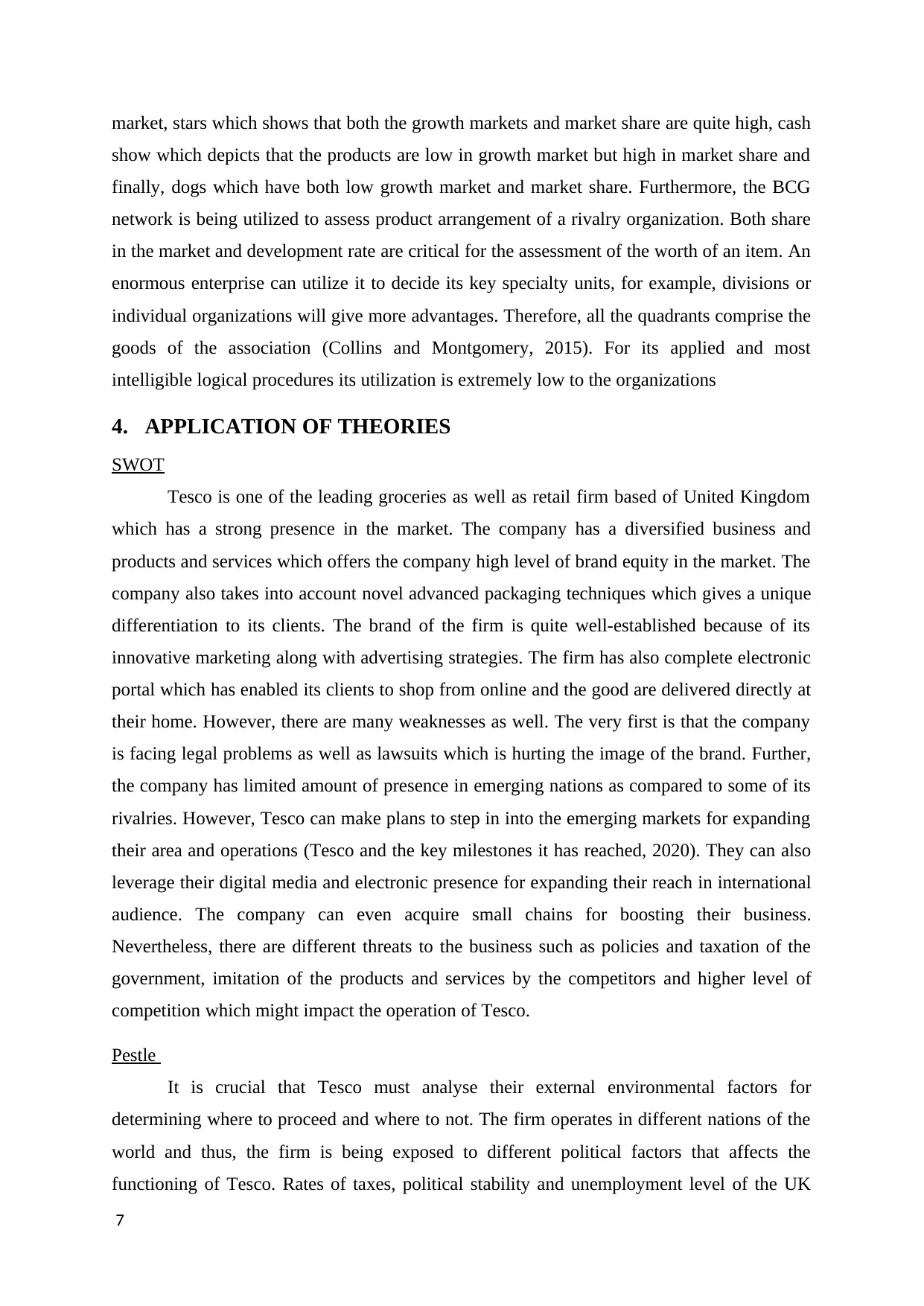
market, stars which shows that both the growth markets and market share are quite high, cash
show which depicts that the products are low in growth market but high in market share and
finally, dogs which have both low growth market and market share. Furthermore, the BCG
network is being utilized to assess product arrangement of a rivalry organization. Both share
in the market and development rate are critical for the assessment of the worth of an item. An
enormous enterprise can utilize it to decide its key specialty units, for example, divisions or
individual organizations will give more advantages. Therefore, all the quadrants comprise the
goods of the association (Collins and Montgomery, 2015). For its applied and most
intelligible logical procedures its utilization is extremely low to the organizations
4. APPLICATION OF THEORIES
SWOT
Tesco is one of the leading groceries as well as retail firm based of United Kingdom
which has a strong presence in the market. The company has a diversified business and
products and services which offers the company high level of brand equity in the market. The
company also takes into account novel advanced packaging techniques which gives a unique
differentiation to its clients. The brand of the firm is quite well-established because of its
innovative marketing along with advertising strategies. The firm has also complete electronic
portal which has enabled its clients to shop from online and the good are delivered directly at
their home. However, there are many weaknesses as well. The very first is that the company
is facing legal problems as well as lawsuits which is hurting the image of the brand. Further,
the company has limited amount of presence in emerging nations as compared to some of its
rivalries. However, Tesco can make plans to step in into the emerging markets for expanding
their area and operations (Tesco and the key milestones it has reached, 2020). They can also
leverage their digital media and electronic presence for expanding their reach in international
audience. The company can even acquire small chains for boosting their business.
Nevertheless, there are different threats to the business such as policies and taxation of the
government, imitation of the products and services by the competitors and higher level of
competition which might impact the operation of Tesco.
Pestle
It is crucial that Tesco must analyse their external environmental factors for
determining where to proceed and where to not. The firm operates in different nations of the
world and thus, the firm is being exposed to different political factors that affects the
functioning of Tesco. Rates of taxes, political stability and unemployment level of the UK
7
show which depicts that the products are low in growth market but high in market share and
finally, dogs which have both low growth market and market share. Furthermore, the BCG
network is being utilized to assess product arrangement of a rivalry organization. Both share
in the market and development rate are critical for the assessment of the worth of an item. An
enormous enterprise can utilize it to decide its key specialty units, for example, divisions or
individual organizations will give more advantages. Therefore, all the quadrants comprise the
goods of the association (Collins and Montgomery, 2015). For its applied and most
intelligible logical procedures its utilization is extremely low to the organizations
4. APPLICATION OF THEORIES
SWOT
Tesco is one of the leading groceries as well as retail firm based of United Kingdom
which has a strong presence in the market. The company has a diversified business and
products and services which offers the company high level of brand equity in the market. The
company also takes into account novel advanced packaging techniques which gives a unique
differentiation to its clients. The brand of the firm is quite well-established because of its
innovative marketing along with advertising strategies. The firm has also complete electronic
portal which has enabled its clients to shop from online and the good are delivered directly at
their home. However, there are many weaknesses as well. The very first is that the company
is facing legal problems as well as lawsuits which is hurting the image of the brand. Further,
the company has limited amount of presence in emerging nations as compared to some of its
rivalries. However, Tesco can make plans to step in into the emerging markets for expanding
their area and operations (Tesco and the key milestones it has reached, 2020). They can also
leverage their digital media and electronic presence for expanding their reach in international
audience. The company can even acquire small chains for boosting their business.
Nevertheless, there are different threats to the business such as policies and taxation of the
government, imitation of the products and services by the competitors and higher level of
competition which might impact the operation of Tesco.
Pestle
It is crucial that Tesco must analyse their external environmental factors for
determining where to proceed and where to not. The firm operates in different nations of the
world and thus, the firm is being exposed to different political factors that affects the
functioning of Tesco. Rates of taxes, political stability and unemployment level of the UK
7
⊘ This is a preview!⊘
Do you want full access?
Subscribe today to unlock all pages.

Trusted by 1+ million students worldwide
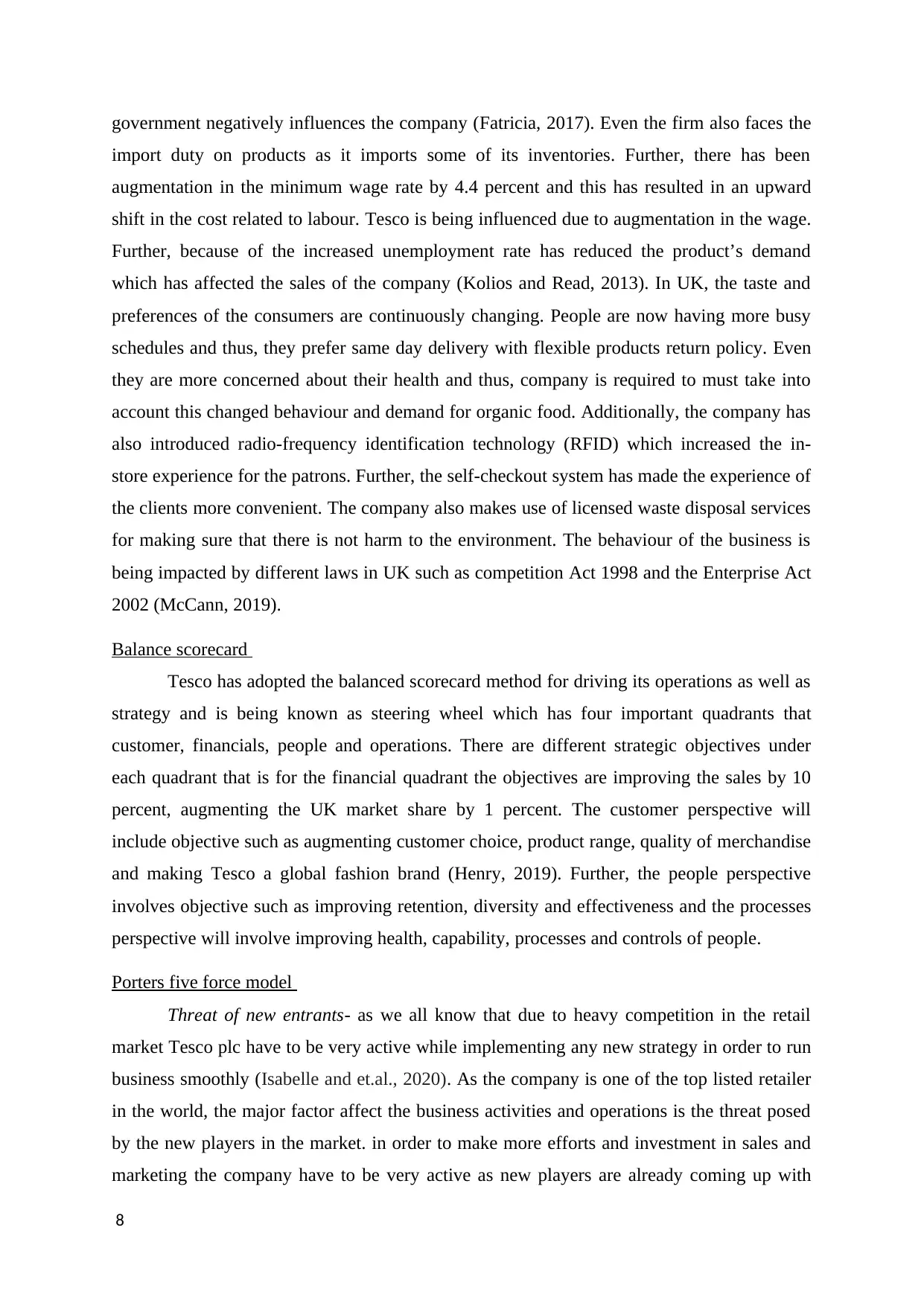
government negatively influences the company (Fatricia, 2017). Even the firm also faces the
import duty on products as it imports some of its inventories. Further, there has been
augmentation in the minimum wage rate by 4.4 percent and this has resulted in an upward
shift in the cost related to labour. Tesco is being influenced due to augmentation in the wage.
Further, because of the increased unemployment rate has reduced the product’s demand
which has affected the sales of the company (Kolios and Read, 2013). In UK, the taste and
preferences of the consumers are continuously changing. People are now having more busy
schedules and thus, they prefer same day delivery with flexible products return policy. Even
they are more concerned about their health and thus, company is required to must take into
account this changed behaviour and demand for organic food. Additionally, the company has
also introduced radio-frequency identification technology (RFID) which increased the in-
store experience for the patrons. Further, the self-checkout system has made the experience of
the clients more convenient. The company also makes use of licensed waste disposal services
for making sure that there is not harm to the environment. The behaviour of the business is
being impacted by different laws in UK such as competition Act 1998 and the Enterprise Act
2002 (McCann, 2019).
Balance scorecard
Tesco has adopted the balanced scorecard method for driving its operations as well as
strategy and is being known as steering wheel which has four important quadrants that
customer, financials, people and operations. There are different strategic objectives under
each quadrant that is for the financial quadrant the objectives are improving the sales by 10
percent, augmenting the UK market share by 1 percent. The customer perspective will
include objective such as augmenting customer choice, product range, quality of merchandise
and making Tesco a global fashion brand (Henry, 2019). Further, the people perspective
involves objective such as improving retention, diversity and effectiveness and the processes
perspective will involve improving health, capability, processes and controls of people.
Porters five force model
Threat of new entrants- as we all know that due to heavy competition in the retail
market Tesco plc have to be very active while implementing any new strategy in order to run
business smoothly (Isabelle and et.al., 2020). As the company is one of the top listed retailer
in the world, the major factor affect the business activities and operations is the threat posed
by the new players in the market. in order to make more efforts and investment in sales and
marketing the company have to be very active as new players are already coming up with
8
import duty on products as it imports some of its inventories. Further, there has been
augmentation in the minimum wage rate by 4.4 percent and this has resulted in an upward
shift in the cost related to labour. Tesco is being influenced due to augmentation in the wage.
Further, because of the increased unemployment rate has reduced the product’s demand
which has affected the sales of the company (Kolios and Read, 2013). In UK, the taste and
preferences of the consumers are continuously changing. People are now having more busy
schedules and thus, they prefer same day delivery with flexible products return policy. Even
they are more concerned about their health and thus, company is required to must take into
account this changed behaviour and demand for organic food. Additionally, the company has
also introduced radio-frequency identification technology (RFID) which increased the in-
store experience for the patrons. Further, the self-checkout system has made the experience of
the clients more convenient. The company also makes use of licensed waste disposal services
for making sure that there is not harm to the environment. The behaviour of the business is
being impacted by different laws in UK such as competition Act 1998 and the Enterprise Act
2002 (McCann, 2019).
Balance scorecard
Tesco has adopted the balanced scorecard method for driving its operations as well as
strategy and is being known as steering wheel which has four important quadrants that
customer, financials, people and operations. There are different strategic objectives under
each quadrant that is for the financial quadrant the objectives are improving the sales by 10
percent, augmenting the UK market share by 1 percent. The customer perspective will
include objective such as augmenting customer choice, product range, quality of merchandise
and making Tesco a global fashion brand (Henry, 2019). Further, the people perspective
involves objective such as improving retention, diversity and effectiveness and the processes
perspective will involve improving health, capability, processes and controls of people.
Porters five force model
Threat of new entrants- as we all know that due to heavy competition in the retail
market Tesco plc have to be very active while implementing any new strategy in order to run
business smoothly (Isabelle and et.al., 2020). As the company is one of the top listed retailer
in the world, the major factor affect the business activities and operations is the threat posed
by the new players in the market. in order to make more efforts and investment in sales and
marketing the company have to be very active as new players are already coming up with
8
Paraphrase This Document
Need a fresh take? Get an instant paraphrase of this document with our AI Paraphraser
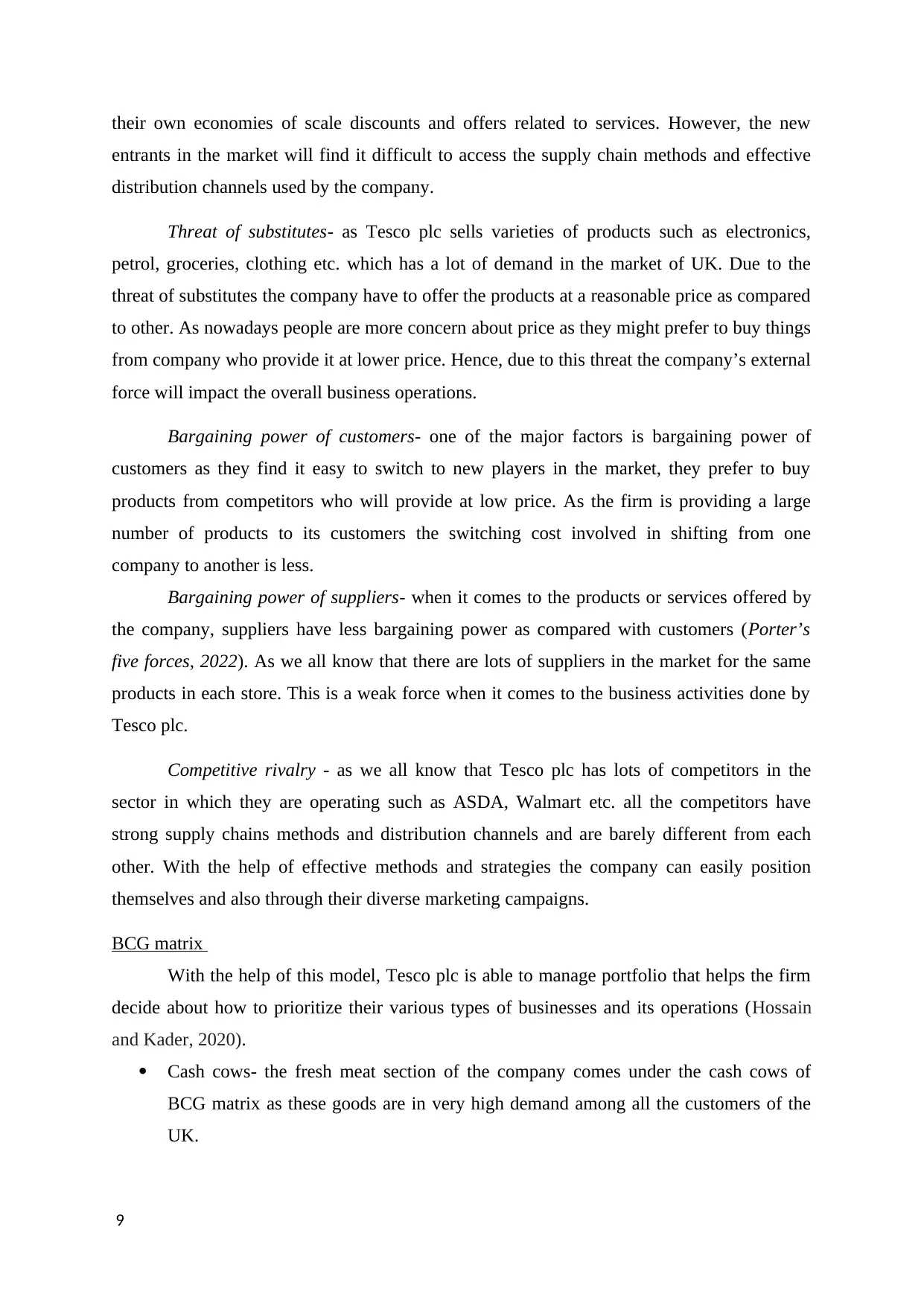
their own economies of scale discounts and offers related to services. However, the new
entrants in the market will find it difficult to access the supply chain methods and effective
distribution channels used by the company.
Threat of substitutes- as Tesco plc sells varieties of products such as electronics,
petrol, groceries, clothing etc. which has a lot of demand in the market of UK. Due to the
threat of substitutes the company have to offer the products at a reasonable price as compared
to other. As nowadays people are more concern about price as they might prefer to buy things
from company who provide it at lower price. Hence, due to this threat the company’s external
force will impact the overall business operations.
Bargaining power of customers- one of the major factors is bargaining power of
customers as they find it easy to switch to new players in the market, they prefer to buy
products from competitors who will provide at low price. As the firm is providing a large
number of products to its customers the switching cost involved in shifting from one
company to another is less.
Bargaining power of suppliers- when it comes to the products or services offered by
the company, suppliers have less bargaining power as compared with customers (Porter’s
five forces, 2022). As we all know that there are lots of suppliers in the market for the same
products in each store. This is a weak force when it comes to the business activities done by
Tesco plc.
Competitive rivalry - as we all know that Tesco plc has lots of competitors in the
sector in which they are operating such as ASDA, Walmart etc. all the competitors have
strong supply chains methods and distribution channels and are barely different from each
other. With the help of effective methods and strategies the company can easily position
themselves and also through their diverse marketing campaigns.
BCG matrix
With the help of this model, Tesco plc is able to manage portfolio that helps the firm
decide about how to prioritize their various types of businesses and its operations (Hossain
and Kader, 2020).
Cash cows- the fresh meat section of the company comes under the cash cows of
BCG matrix as these goods are in very high demand among all the customers of the
UK.
9
entrants in the market will find it difficult to access the supply chain methods and effective
distribution channels used by the company.
Threat of substitutes- as Tesco plc sells varieties of products such as electronics,
petrol, groceries, clothing etc. which has a lot of demand in the market of UK. Due to the
threat of substitutes the company have to offer the products at a reasonable price as compared
to other. As nowadays people are more concern about price as they might prefer to buy things
from company who provide it at lower price. Hence, due to this threat the company’s external
force will impact the overall business operations.
Bargaining power of customers- one of the major factors is bargaining power of
customers as they find it easy to switch to new players in the market, they prefer to buy
products from competitors who will provide at low price. As the firm is providing a large
number of products to its customers the switching cost involved in shifting from one
company to another is less.
Bargaining power of suppliers- when it comes to the products or services offered by
the company, suppliers have less bargaining power as compared with customers (Porter’s
five forces, 2022). As we all know that there are lots of suppliers in the market for the same
products in each store. This is a weak force when it comes to the business activities done by
Tesco plc.
Competitive rivalry - as we all know that Tesco plc has lots of competitors in the
sector in which they are operating such as ASDA, Walmart etc. all the competitors have
strong supply chains methods and distribution channels and are barely different from each
other. With the help of effective methods and strategies the company can easily position
themselves and also through their diverse marketing campaigns.
BCG matrix
With the help of this model, Tesco plc is able to manage portfolio that helps the firm
decide about how to prioritize their various types of businesses and its operations (Hossain
and Kader, 2020).
Cash cows- the fresh meat section of the company comes under the cash cows of
BCG matrix as these goods are in very high demand among all the customers of the
UK.
9
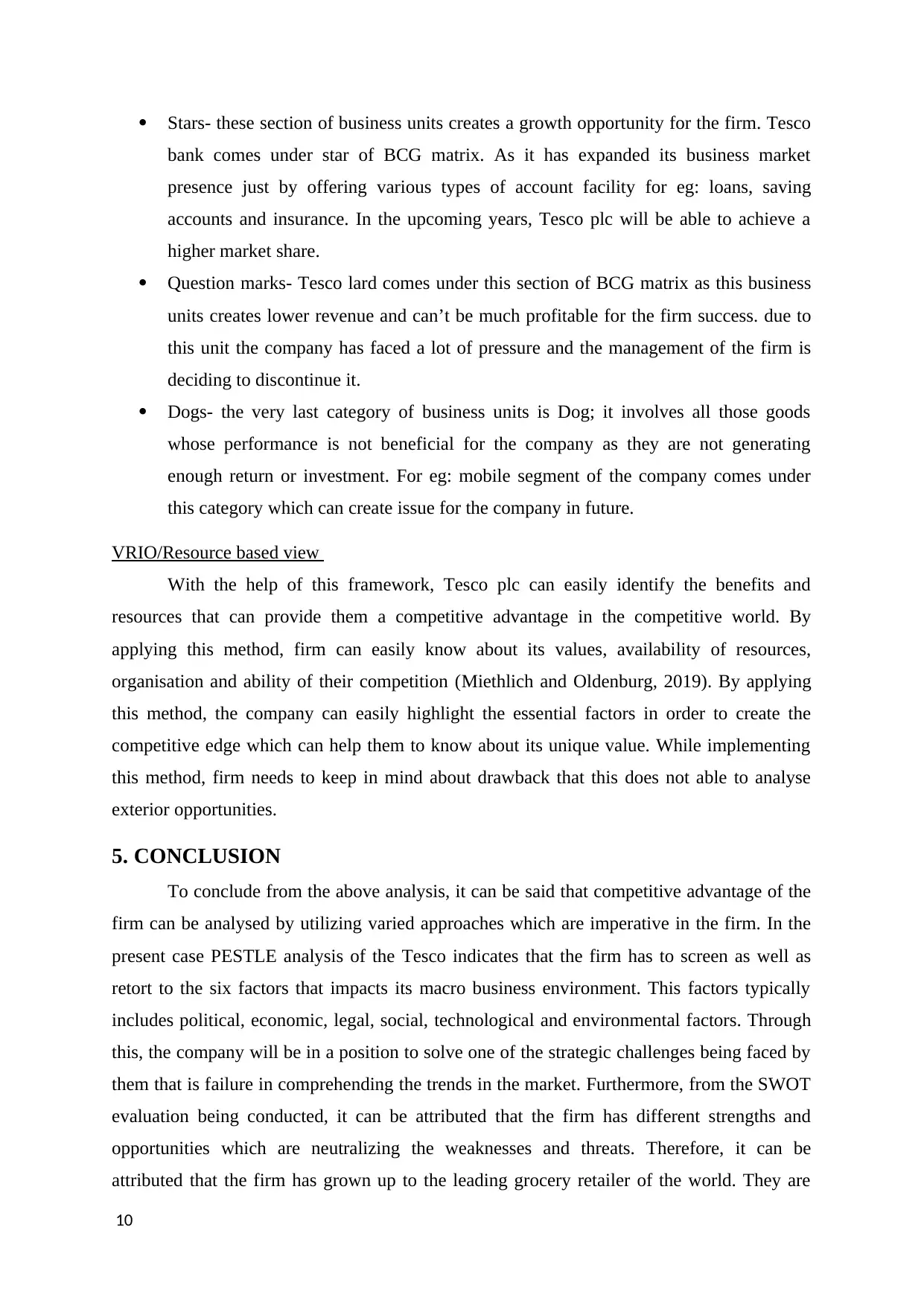
Stars- these section of business units creates a growth opportunity for the firm. Tesco
bank comes under star of BCG matrix. As it has expanded its business market
presence just by offering various types of account facility for eg: loans, saving
accounts and insurance. In the upcoming years, Tesco plc will be able to achieve a
higher market share.
Question marks- Tesco lard comes under this section of BCG matrix as this business
units creates lower revenue and can’t be much profitable for the firm success. due to
this unit the company has faced a lot of pressure and the management of the firm is
deciding to discontinue it.
Dogs- the very last category of business units is Dog; it involves all those goods
whose performance is not beneficial for the company as they are not generating
enough return or investment. For eg: mobile segment of the company comes under
this category which can create issue for the company in future.
VRIO/Resource based view
With the help of this framework, Tesco plc can easily identify the benefits and
resources that can provide them a competitive advantage in the competitive world. By
applying this method, firm can easily know about its values, availability of resources,
organisation and ability of their competition (Miethlich and Oldenburg, 2019). By applying
this method, the company can easily highlight the essential factors in order to create the
competitive edge which can help them to know about its unique value. While implementing
this method, firm needs to keep in mind about drawback that this does not able to analyse
exterior opportunities.
5. CONCLUSION
To conclude from the above analysis, it can be said that competitive advantage of the
firm can be analysed by utilizing varied approaches which are imperative in the firm. In the
present case PESTLE analysis of the Tesco indicates that the firm has to screen as well as
retort to the six factors that impacts its macro business environment. This factors typically
includes political, economic, legal, social, technological and environmental factors. Through
this, the company will be in a position to solve one of the strategic challenges being faced by
them that is failure in comprehending the trends in the market. Furthermore, from the SWOT
evaluation being conducted, it can be attributed that the firm has different strengths and
opportunities which are neutralizing the weaknesses and threats. Therefore, it can be
attributed that the firm has grown up to the leading grocery retailer of the world. They are
10
bank comes under star of BCG matrix. As it has expanded its business market
presence just by offering various types of account facility for eg: loans, saving
accounts and insurance. In the upcoming years, Tesco plc will be able to achieve a
higher market share.
Question marks- Tesco lard comes under this section of BCG matrix as this business
units creates lower revenue and can’t be much profitable for the firm success. due to
this unit the company has faced a lot of pressure and the management of the firm is
deciding to discontinue it.
Dogs- the very last category of business units is Dog; it involves all those goods
whose performance is not beneficial for the company as they are not generating
enough return or investment. For eg: mobile segment of the company comes under
this category which can create issue for the company in future.
VRIO/Resource based view
With the help of this framework, Tesco plc can easily identify the benefits and
resources that can provide them a competitive advantage in the competitive world. By
applying this method, firm can easily know about its values, availability of resources,
organisation and ability of their competition (Miethlich and Oldenburg, 2019). By applying
this method, the company can easily highlight the essential factors in order to create the
competitive edge which can help them to know about its unique value. While implementing
this method, firm needs to keep in mind about drawback that this does not able to analyse
exterior opportunities.
5. CONCLUSION
To conclude from the above analysis, it can be said that competitive advantage of the
firm can be analysed by utilizing varied approaches which are imperative in the firm. In the
present case PESTLE analysis of the Tesco indicates that the firm has to screen as well as
retort to the six factors that impacts its macro business environment. This factors typically
includes political, economic, legal, social, technological and environmental factors. Through
this, the company will be in a position to solve one of the strategic challenges being faced by
them that is failure in comprehending the trends in the market. Furthermore, from the SWOT
evaluation being conducted, it can be attributed that the firm has different strengths and
opportunities which are neutralizing the weaknesses and threats. Therefore, it can be
attributed that the firm has grown up to the leading grocery retailer of the world. They are
10
⊘ This is a preview!⊘
Do you want full access?
Subscribe today to unlock all pages.

Trusted by 1+ million students worldwide
1 out of 17
Related Documents
Your All-in-One AI-Powered Toolkit for Academic Success.
+13062052269
info@desklib.com
Available 24*7 on WhatsApp / Email
![[object Object]](/_next/static/media/star-bottom.7253800d.svg)
Unlock your academic potential
Copyright © 2020–2025 A2Z Services. All Rights Reserved. Developed and managed by ZUCOL.



